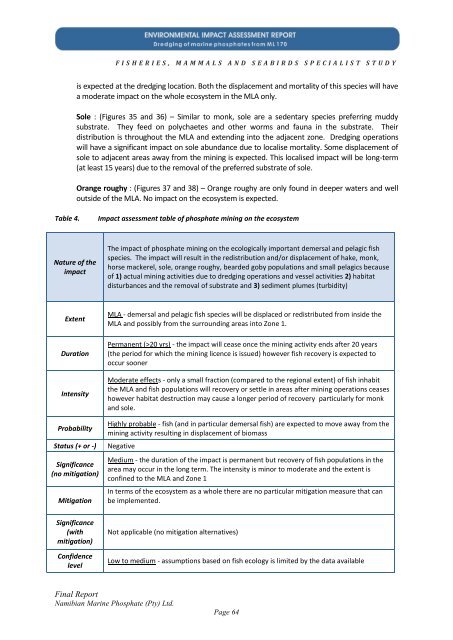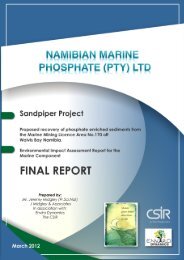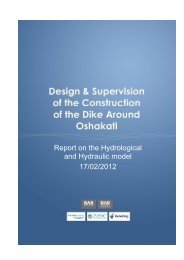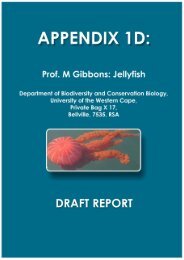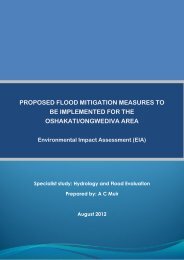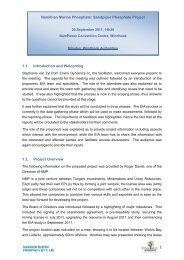Fisheries - Enviro Dynamics Namibia
Fisheries - Enviro Dynamics Namibia
Fisheries - Enviro Dynamics Namibia
You also want an ePaper? Increase the reach of your titles
YUMPU automatically turns print PDFs into web optimized ePapers that Google loves.
F I S H E R I E S , M A M M A L S A N D S E A B I R D S S P E C I A L I S T S T U D Y<br />
is expected at the dredging location. Both the displacement and mortality of this species will have<br />
a moderate impact on the whole ecosystem in the MLA only.<br />
Sole : (Figures 35 and 36) – Similar to monk, sole are a sedentary species preferring muddy<br />
substrate. They feed on polychaetes and other worms and fauna in the substrate. Their<br />
distribution is throughout the MLA and extending into the adjacent zone. Dredging operations<br />
will have a significant impact on sole abundance due to localise mortality. Some displacement of<br />
sole to adjacent areas away from the mining is expected. This localised impact will be long-term<br />
(at least 15 years) due to the removal of the preferred substrate of sole.<br />
Orange roughy : (Figures 37 and 38) – Orange roughy are only found in deeper waters and well<br />
outside of the MLA. No impact on the ecosystem is expected.<br />
Table 4. Impact assessment table of phosphate mining on the ecosystem<br />
Nature of the<br />
impact<br />
Extent<br />
Duration<br />
Intensity<br />
Probability<br />
Status (+ or -) Negative<br />
Significance<br />
(no mitigation)<br />
Mitigation<br />
Significance<br />
(with<br />
mitigation)<br />
Confidence<br />
level<br />
The impact of phosphate mining on the ecologically important demersal and pelagic fish<br />
species. The impact will result in the redistribution and/or displacement of hake, monk,<br />
horse mackerel, sole, orange roughy, bearded goby populations and small pelagics because<br />
of 1) actual mining activities due to dredging operations and vessel activities 2) habitat<br />
disturbances and the removal of substrate and 3) sediment plumes (turbidity)<br />
MLA - demersal and pelagic fish species will be displaced or redistributed from inside the<br />
MLA and possibly from the surrounding areas into Zone 1.<br />
Permanent (>20 yrs) - the impact will cease once the mining activity ends after 20 years<br />
(the period for which the mining licence is issued) however fish recovery is expected to<br />
occur sooner<br />
Moderate effects - only a small fraction (compared to the regional extent) of fish inhabit<br />
the MLA and fish populations will recovery or settle in areas after mining operations ceases<br />
however habitat destruction may cause a longer period of recovery particularly for monk<br />
and sole.<br />
Highly probable - fish (and in particular demersal fish) are expected to move away from the<br />
mining activity resulting in displacement of biomass<br />
Medium - the duration of the impact is permanent but recovery of fish populations in the<br />
area may occur in the long term. The intensity is minor to moderate and the extent is<br />
confined to the MLA and Zone 1<br />
In terms of the ecosystem as a whole there are no particular mitigation measure that can<br />
be implemented.<br />
Not applicable (no mitigation alternatives)<br />
Low to medium - assumptions based on fish ecology is limited by the data available<br />
Final Report<br />
<strong>Namibia</strong>n Marine Phosphate (Pty) Ltd.<br />
Page 64


